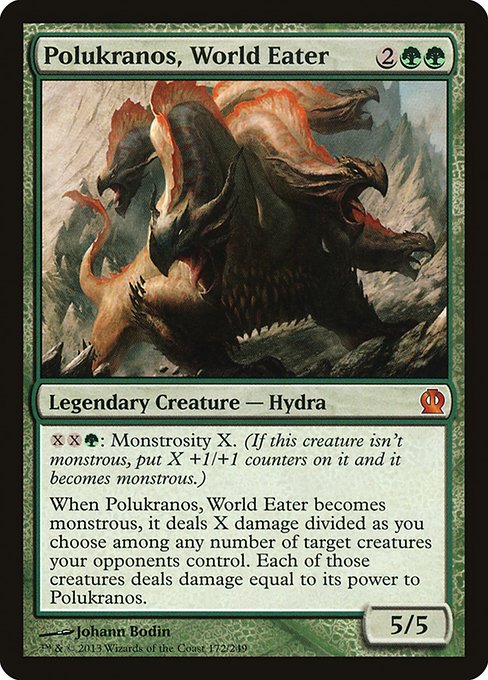
Image courtesy of Scryfall.com
Economic analysis of sealed product scarcity in MTG: a Polukranos case study
If you’ve ever chased a sealed product as a collector or dreamed of a pristine foil that shines brighter than a Hydra’s glittering facets, you know the thrill—and the anxiety—of MTG’s secondary market. Polukranos, World Eater, a mythic behemoth from Theros (set code THS), sits at an intriguing crossroads of design, rarity, and economic behavior. This article digs into how sealed product scarcity forms, how it ripples into pricing for single cards like Polukranos, and what it means for players who are trying to forecast value over time 🧙🔥💎⚔️. The card’s green thunder, Monstrosity, and its flavorful artwork by Johann Bodin aren’t just eye candy—they’re data points in a broader economy that rewards patience, timing, and a little bit of luck 🎨🎲.
The card in focus: what Polukranos actually does
Polukranos, World Eater is a Legendary Creature — Hydra with a distinctive twist: {X}{X}{G}: Monstrosity X. If you pay X + X + G, you can push Polukranos into monstrosity, a state that dramatically alters its interaction on the battlefield. When it becomes monstrous, it deals X damage divided among any number of target creatures your opponents control. Each of those creatures deals damage equal to its power to Polukranos. In vanilla terms, you’re turning a 5/5 into a damage-delivery system that can swing games through mass removal or attrition—an elegant, slightly feral milestone from the Theros block 🧙🔥. It’s a 5/5 for 4 mana (2GG), already a sturdy frame for green ramp and midrange strategies that prize survivability and board impact.
- Mana cost: {2}{G}{G} (CMC 4)
- Rarity: Mythic
- Color identity: Green
- Set: TherOS (THEROS)
- Mechanic: Monstrosity
Its mythic status and distinct gameplay slot help explain why Polukranos remains a talking point for sealed-product scarcity. A compact booster-era narrative—few players open boxes in 2013 and still actively pull a foil Polukranos today—drives a measurable premium on sealed product relative to common nonfoil singles, even as the card remains accessible in various printings. The art and design are part of the package, but the economics are where the real story lives 🧙♂️💎.
Sealed product scarcity: the mechanics behind the market
Sealed-product scarcity isn’t just about “how rare is the card.” It’s about the life cycle of a printing block: initial release, distribution to retailers, ongoing supply in the market, and eventual decay as print cycles move on. For Theros-era sets, the supply dynamics included booster packs and event decks that poured out initial volume, followed by slower, more selective reprint activity. As time passes, the physical product becomes harder to locate in fresh condition, and the marginal utility of pulling a high-value mythic from a sealed box increases for collectors who value the unopened experience as a premium commodity 🧲🎯.
The numbers you’ll see in market feeds—USD 0.82 for nonfoil Polukranos, USD 2.21 for foil, and modest euro equivalents—reflect current liquidity and niche demand rather than purely intrinsic rarity. These prices are influenced by several factors beyond the card’s own power level: historical demand in Commander and other formats, the appeal of foil vs. nonfoil, and general shifts in sealed-box ownership among newer players who view older sets as both nostalgia and a potential investment. The fragrance of scarcity—paired with a strong green card that scales with X—keeps Polukranos in a polite but persistent price band, even as broader market volatility tickles the edges 📈🧭.
Where scarcity meets strategy: implications for players and collectors
For players who rely on Polukranos in drafts or sealed formats, scarcity translates into a practical reality: fewer pristine copies available over time means heightened attention to condition and potential price floors for foil prints. For collectors, the card’s enduring mythic status in a beloved block makes Polukranos a candidate for long-run appreciation, especially in foil form where the premium is most pronounced. The Theros set and its mythics occupy a niche—a bridge between the romantic era of Limited play and the modern, price-sensitive post-rotation market. The “value” isn’t just a number; it’s the story of a card that embodies a moment in the game’s evolution and a reminder that sealed product is a long-term bet as much as a thrill ride ⚔️🧿.
“Scarcity is the quiet engine of pricing; rarity whispers in the ear of every ETB and every sealed case.”
Practical takeaways for budgeting and collection-building
- Track both single-card prices and sealed product trends to gauge if a newer set’s scarcity is feeding into older mythics like Polukranos.
- Foil versions generally command a premium; consider whether you want display-quality artifacts or playable copies for decks.
- Keep an eye on reprint risk announcements. A reprint can reset scarcity dynamics quickly, reshuffling value across both sealed and singles.
- Leverage cross-promotional opportunities—for instance, pairing your MTG interest with a stylish desk accessory like the Neon Phone Stand, which can be promoted alongside content that celebrates the vibe of collecting and display 🧙🎨.
Cross-promotional note: a desk setup for the MTG aficionado
As you build a display-worthy collection, small desk upgrades can brighten your play area and your wallet’s peace of mind. If you’re exploring tasteful, practical desk décor, consider a Neon Phone Stand for Smartphones—Two-Piece Desk Decor & Travel. It’s a neat counterpart to your favorite mythics, a reminder that the magic of MTG extends beyond the battlefield and into everyday spaces. You can check out the product here: Neon Phone Stand for Smartphones — Two-Piece Desk Decor & Travel 🧙🔥💎.
For those who want to dive deeper into Polukranos’ lineage and the Theros era, Scryfall remains a reliable compass. The card’s original illustrations, set context, and rulings history are excellent reference points for crafting informed, data-driven decks and collecting goals that feel both nostalgic and practical 🧭🎲.